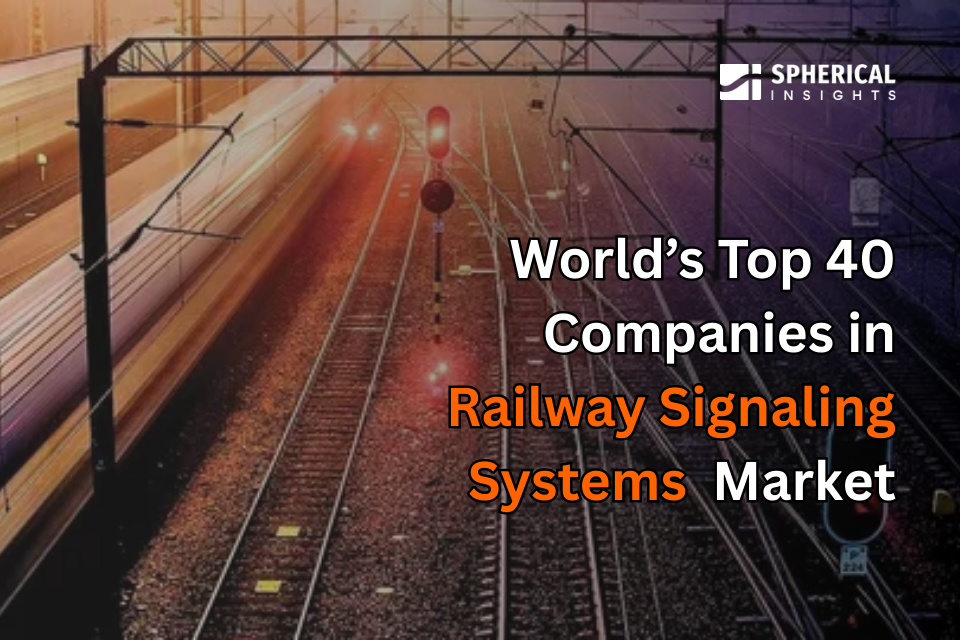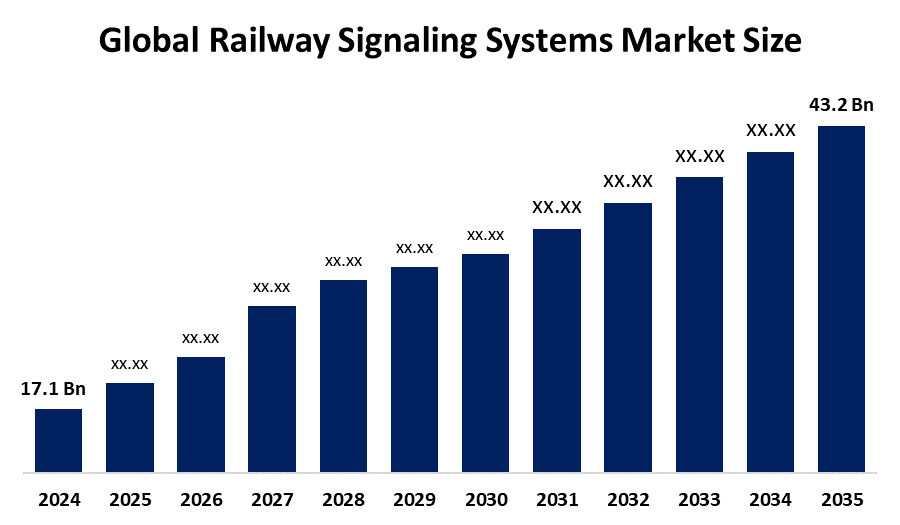
World’s Top 40 Companies in Railway Signaling Systems 2025 Watchlist: Statistical Report (2024–2035)
RELEASE DATE: Sep 2025 Author: Spherical InsightsRequest Free Sample Speak to Analyst
Description
According to a research report published by Spherical Insights & Consulting, The Global Railway Signaling Systems Market Size is projected to Grow from USD 17.1 Billion in 2024 to USD 43.2 Billion by 2035, at a CAGR of 8.79% during the forecast period 2025–2035. The global railway signaling systems market is witnessing significant growth driven by increasing rail traffic and network expansion, modernization of aging infrastructure, and technological advancements.
Introduction
The Global Railway Signaling Systems Market Size encompasses the industry involved in designing, manufacturing, and implementing technologies that control train movements, ensure safety, and optimize rail network efficiency. Railway signaling systems include automatic block signaling, centralized traffic control, communication-based train control (CBTC), and automatic train protection (ATP), which enable safe train operations, prevent collisions, and improve punctuality. The market is driven by increasing rail traffic, modernization of aging infrastructure, and the expansion of urban transit and high-speed rail networks. Governments throughout the world are investing considerably in signal modifications to fulfill demanding safety standards and promote sustainable transportation programs. Artificial intelligence, the Internet of Things, and big data analytics have improved real-time monitoring, predictive maintenance, and operational efficiency. Furthermore, the increasing use of railway telematics systems, which combine data collecting, communication, and analytics, is augmenting signalling solutions by improving fleet management, monitoring, and control capabilities. With an increasing emphasis on safety, efficiency, and sustainable operations, the worldwide railway signalling systems market is positioned for considerable development over the next decade.
Navigate Future Markets with Confidence: Insights from Spherical Insights LLP
The insights presented in this blog are derived from comprehensive market research conducted by Spherical Insights LLP, a trusted advisory partner to leading global enterprises. Backed by in-depth data analysis, expert forecasting, and industry-specific intelligence, our reports empower decision-makers to identify strategic growth opportunities in fast-evolving sectors. Clients seeking detailed market segmentation, competitive landscapes, regional outlooks, and future investment trends will find immense value in the full report. By leveraging our research, businesses can make informed decisions, gain a competitive edge, and stay ahead in the transition toward sustainable and profitable solutions.
Unlock exclusive market insights - Download the Brochure now and dive deeper into the future of the Railway Signaling Systems Market.
Railway Signaling Systems Market Size & Statistics
- The Market Size for Railway Signaling Systems Was Estimated to be worth USD 17.1 Billion in 2024.
- The Market Size is Going to Expand at a CAGR of 8.79% between 2025 and 2035.
- The Global Railway Signaling Systems Market Size is anticipated to reach USD 43.2 Billion by 2035.
- North America is expected to generate the highest demand during the forecast period in the Railway Signaling Systems Market
- Asia Pacific is expected to grow the fastest during the forecast period in the Railway Signaling Systems Market.

Regional growth and demand
Asia Pacific is expected to grow the fastest during the forecast period in the Railway Signaling Systems market. Asia Pacific is expected to grow fastest in the railway signaling systems market due to rapid urbanization, expansion of high-speed and metro rail networks, government investments in modern infrastructure, increasing rail traffic, and the adoption of advanced signaling technologies for safer and efficient operations.
North America is expected to generate the highest demand during the forecast period in the Railway Signaling Systems market. North America is expected to generate the highest demand in the railway signaling systems market due to its extensive rail network, focus on modernizing aging infrastructure, strict safety regulations, high passenger and freight traffic, and investments in advanced signaling technologies.
Top 10 Trends in the Railway Signaling Systems Market
- AI and Machine Learning Integration
- IoT and Wireless Technology
- Advanced Communication Systems
- Shift to Automation
- Increased Investment in Modernization
- Focus on Cybersecurity
- Cloud-Based Platforms
- Standardization via ETCS
- Autonomous Train Operations
- Enhanced Safety and Efficiency
1. AI and Machine Learning Integration
Artificial intelligence and machine learning are rapidly being used to optimize train scheduling, forecast maintenance requirements, improve safety, and allow for real-time decision-making. These solutions increase operational efficiency while lowering the danger of human mistakes in signaling systems.
2. IoT and Wireless Technology
The integration of IoT devices with wireless communication enables real-time monitoring of trains, tracks, and signaling equipment. This enables predictive maintenance, lowers downtime, and improves operating safety and dependability.
3. Advanced Communication Systems
The use of current communication-based train control (CBTC), automated train control (ATC), and other advanced communication technologies increases train-to-train and train-to-control-center interactions, resulting in better traffic management and faster reaction to disturbances.
4. Shift to Automation
Automation in signaling systems, such as automatic train protection (ATP) and automated route management, improves safety, decreases human involvement, and boosts rail efficiency, particularly in urban and high-density corridors.
5. Increased Investment in Modernization
Governments and corporate organizations are making significant investments in modernizing outdated rail infrastructure and signaling systems, as well as introducing digital and intelligent technologies to satisfy safety standards, enable high-speed train, and maximize network capacity.
Empower your strategic planning:
Stay informed with the latest industry insights and market trends to identify new opportunities and drive growth in the railway signaling systems market. To explore more in-depth trends, insights, and forecasts, please refer to our detailed report.
Top 25 Companies Leading the Railway Signaling Systems Market
- Alstom SA
- Siemens AG
- Hitachi Ltd.
- Thales Group
- Bombardier Inc.
- CAF Group
- Nippon Signal Co., Ltd.
- Ansaldo STS (Hitachi Rail STS)
- China Railway Signal & Communication Corporation Limited (CRSC)
- Wabtec Corporation
- Mitsubishi Electric Corporation
- GE Transportation
- Indra Sistemas, S.A.
- Kyosan Electric Manufacturing Co., Ltd.
- Schneider Electric SE
- ABB Ltd.
- L&T Technology Services
- Hollysys Automation Technologies Ltd.
- Mermec Group
- Siemens Mobility
- Huawei Technologies Co., Ltd.
- Nokia Corporation
- Belden Inc.
- Pintsch Bamag GmbH
- Alvarion Ltd.
1. Alstom SA
Headquarters: Saint-Ouen-sur-Seine, France
Alstom SA, based in Saint-Ouen-sur-Seine, France, is a global leader in rail transport systems with operations in over 60 countries. The firm specializes in delivering integrated signaling systems for urban and mainline rail networks, resulting in safer and more efficient train operations. Alstom's innovative signaling systems, including communication-based train control (CBTC) and automated train protection (ATP), improve traffic management, increase operational dependability, and minimize collision risks. Alstom strengthens its position as a significant player in the global railway signaling industry by combining innovation and vast global knowledge to help rail operators improve network capacity, timeliness, and passenger safety.
2. Siemens AG
Headquarters: Munich, Germany
Siemens AG, based in Munich, Germany, has operations in more than 190 countries and is a prominent provider of rail signaling systems through its Siemens Mobility subsidiary. The firm provides flexible and dependable signaling systems for mass transit, mainline, and freight rail networks, which improve operating efficiency and safety. Siemens' sophisticated technologies, such as communication-based train control (CBTC) and automated train control (ATC), improve traffic flow, decrease delays, and enable high-density rail operations. Siemens helps train operators increase network reliability, safety, and capacity, strengthening its position as a significant player in the global railway signaling business.
3. HITACHI LTD.
Headquarters: Tokyo, Japan
Hitachi Ltd., based in Tokyo, Japan, works in more than 50 countries, providing smart and sustainable rail solutions. The company's subsidiary Hitachi train provides integrated signaling systems, digital mobility solutions, and services aimed at improving train efficiency, safety, and dependability. Hitachi's technologies, such as automated train protection (ATP) and communication-based train control (CBTC), help to streamline operations, decrease delays, and improve passenger experience. Hitachi's worldwide knowledge and dedication to innovation allow train operators to update infrastructure, boost network capacity, and ensure safer operations, making it a vital contributor to the global railway signalling systems market.
4. Thales Group
Headquarters: La Défense, France
Thales Group, based in La Défense, France, works in over 50 countries and provides modern rail signaling technologies such as ETCS, CBTC, and interlocking systems. The organization focuses on improving rail network safety, efficiency, and performance at the urban, regional, and mainline levels. Thales' signaling technology offers real-time monitoring, automated control, and dependable traffic management, resulting in fewer accidents and operational disruptions. Thales has established itself as a significant participant in the worldwide railway signaling systems market by combining innovation and global knowledge to assist train operators in updating infrastructure, increasing capacity, and providing safer and more efficient rail transport solutions.
5. Bombardier Inc.
Headquarters: Montreal, Canada
Bombardier Inc., based in Montreal, Canada, operates in more than 25 countries and provides technology such as the INTERFLO mainline signaling system to improve rail safety and efficiency. Bombardier's signaling systems optimize traffic management, decrease delays, and increase network dependability for passenger and freight operations. Its legacy continues to impact current signaling technology, helping to modernize train networks throughout the world. Bombardier's innovation and global reach contribute significantly to safer, more efficient, and reliable railway operations.
Are you ready to discover more about the railway signaling systems market?
The report provides an in-depth analysis of the leading companies operating in the global railway signaling systems market. It includes a comparative assessment based on their product portfolios, business overviews, geographical footprint, strategic initiatives, market segment share, and SWOT analysis. Each company is profiled using a standardized format that includes:
Company Profiles
- Alstom SA
- Business Overview
- Company Snapshot
- Products Overview
- Company Market Share Analysis
- Company Coverage Portfolio
- Financial Analysis
- Recent Developments
- Merger and Acquisitions
- SWOT Analysis
- Siemens AG
- HITACHI LTD.
- Thales Group
- Bombardier Inc.
- CAF Group
- Nippon Signal Co., Ltd.
- Ansaldo STS (Hitachi Rail STS)
- China Railway Signal & Communication Corporation Limited (CRSC)
- Others.
Conclusion
The global railway signaling systems market is poised for significant growth, driven by increasing rail traffic, expansion of high-speed and urban rail networks, and the modernization of aging infrastructure. Advanced technologies such as AI, IoT, communication-based train control (CBTC), and automatic train protection (ATP) are enhancing operational efficiency, safety, and real-time monitoring. Governments and private entities are investing heavily in signaling upgrades to meet stringent safety standards and support sustainable transportation. Key players such as Alstom, Siemens, Hitachi, Thales, and Bombardier are leading the market by providing innovative, reliable, and integrated solutions that optimize network performance and ensure safe rail operations globally.
About the Spherical Insights & Consulting
Spherical Insights & Consulting is a market research and consulting firm which provides actionable market research study, quantitative forecasting and trends analysis provides forward-looking insight especially designed for decision makers and aids ROI.
Which is catering to different industry such as financial sectors, industrial sectors, government organizations, universities, non-profits and corporations. The company's mission is to work with businesses to achieve business objectives and maintain strategic improvements.
CONTACT US:
For More Information on Your Target Market, Please Contact Us Below:
Phone: +1 303 800 4326 (the U.S.)
Phone: +91 90289 24100 (APAC)
Email: inquiry@sphericalinsights.com, sales@sphericalinsights.com
Contact Us: https://www.sphericalinsights.com/contact-us
Need help to buy this report?